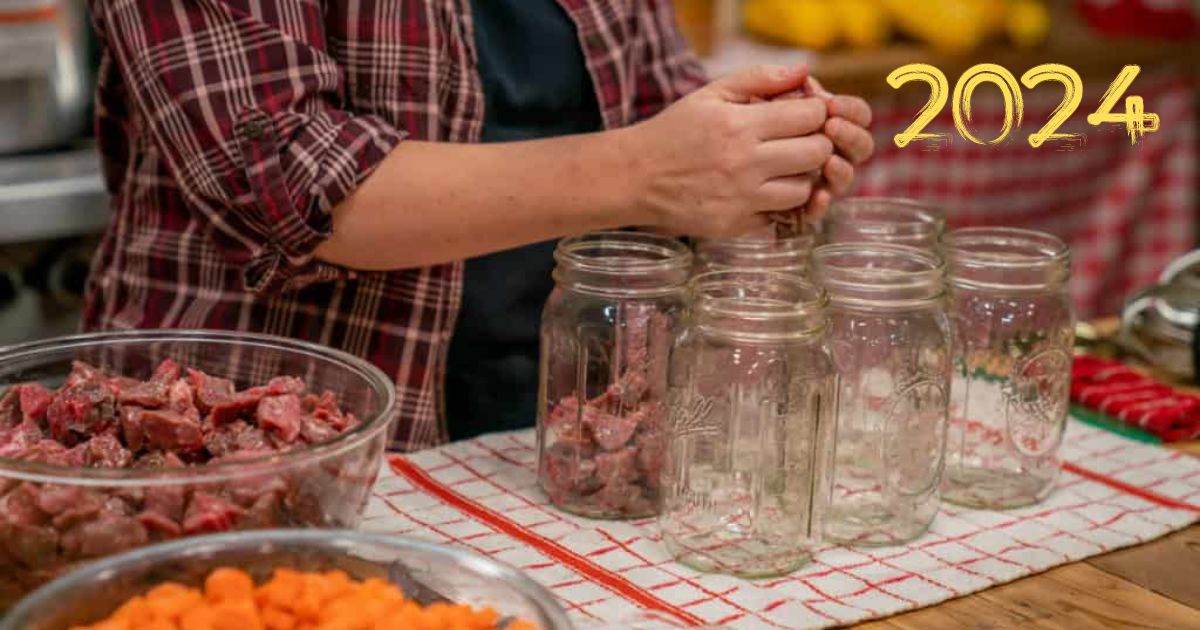Beef stew is used to cook beef, veggies, and seasonings to create a filling and cosy dish known as beef stew. It is a traditional comfort food that is loved by American families throughout.
Ever wondered about the convenience of having a delicious meal ready to eat at any time? That’s where canned beef stew comes in. Canned beef stew offers the same rich flavors and nourishment as homemade, but with the added benefit of long-term storage and quick preparation.
Whether you’re looking for a convenient meal option for busy weeknights or stocking your pantry for emergencies, canned beef stew is a versatile and flavorful choice. Simply heat it up on the stove or microwave, and you’ll have a satisfying meal in minutes.
Art of Canning Beef Stew
Mastering the art of canning beef stew ensures flavorful meals at your fingertips. With quality ingredients and proper techniques, seal in the rich flavors for convenient enjoyment anytime. Elevate your culinary skills and stock your pantry with homemade goodness.
Home-Canned Beef Stew Recipes
Canning beef stew at home can be a rewarding way to preserve a delicious and hearty meal for later consumption. Here’s a basic recipe for home-canned beef stew:
Ingredients:
– 4 lbs of beef stew meat, cubed
– 4 cups beef broth
– 4 cups water
– 4 cups peeled and diced potatoes
– 2 cups chopped carrots
– 2 cups chopped celery
– 2 cups chopped onions
– 1 cup chopped tomatoes (optional)
– Salt and pepper to taste
– 2 cloves garlic, minced (optional)
– 1 teaspoon dried thyme
– 1 teaspoon dried rosemary
– 1 teaspoon dried parsley
Instructions:
1. Prepare the Beef: Trim excess fat from the beef stew meat and cut it into bite-sized cubes.
2. Prepare the Vegetables: Peel and dice the potatoes, chop the carrots, celery, onions, and tomatoes (if using).
3. Sterilize Jars: Wash canning jars, lids, and rings in hot, soapy water, and rinse well. Sterilize the jars by boiling them in a large pot of water for 10 minutes. Keep them in hot water until ready to use.
4. Prepare the Stew: In a large pot, combine the beef stew meat, beef broth, water, potatoes, carrots, celery, onions, tomatoes (if using), garlic (if using), thyme, rosemary, parsley, salt, and pepper. Bring the mixture to a boil, then reduce the heat and simmer for 5 minutes.
5. Fill Jars: Ladle the hot stew into the sterilized jars, leaving about 1 inch of headspace at the top of each jar.
6. Remove Air Bubbles: Slide a non-metallic spatula or chopstick down the sides of the jars to remove any air bubbles.
7. Wipe Jar Rims: Wipe the rims of the jars with a clean, damp cloth to ensure a good seal.
8. Attach Lids: Place the sterilized lids on the jars and screw on the rings until they are fingertip tight.
9. Process Jars: Place the filled jars in a pressure canner according to the manufacturer’s instructions. Process at 10 pounds pressure for 90 minutes for pint jars and 75 minutes for quart jars.
10. Cool and Store: Once the processing time is complete, turn off the heat and allow the pressure canner to depressurize naturally. Remove the jars carefully and place them on a towel or wooden surface to cool. As they cool, you should hear the lids “pop” as they seal. Once cooled, check the seals by pressing down on the center of each lid. If the lid doesn’t flex, it’s sealed properly. Any unsealed jars should be refrigerated and consumed within a few days.
11. Label and Store: Label each jar with the contents and date before storing them in a cool, dark place. Properly canned beef stew can last for up to a year or more when stored correctly.
Enjoy your homemade canned beef stew whenever you need a quick and hearty meal!
Hot Pack vs. Cold Pack In Canning Beef Stew
Hot packing and cold packing are two methods used in home canning, including canning beef stew. Each method has its benefits and considerations:
1. Hot Packing:
– In hot packing, the stew is cooked before placing it in jars, typically simmering for a period of time.
– The hot stew is then packed into hot jars and sealed immediately.
– Hot packing is believed to help food retain its color, flavor, and texture better compared to cold packing.
– This method can also help remove air bubbles from the food, which is important for proper sealing and preservation.
2. Cold Packing:
– In cold packing, also known as raw packing, the stew is not cooked before packing into jars. Instead, raw ingredients are layered directly into the jars.
– A hot liquid, such as broth or water, is then poured over the ingredients before sealing the jars.
– Cold packing is typically faster and requires less energy because there’s no pre-cooking involved.
– However, some argue that cold packed foods may not retain their color, flavor, and texture as well as those that are hot packed.
When canning beef stew, both methods can be used, but it’s essential to follow a tested recipe and canning guidelines provided by reliable sources, such as the USDA or the National Center for Home Food Preservation. These guidelines ensure the safety of the canned product by preventing the growth of harmful bacteria like Clostridium botulinum.
Here’s a general process for canning beef stew using either method:
1. Preparation:
– Gather all necessary equipment, including canning jars, lids, rings, a pressure canner (for low-acid foods like meat), and utensils.
– Prepare the beef stew according to a tested recipe, ensuring all ingredients are fresh and of high quality.
2. Hot Packing:
– Cook the beef stew according to the recipe until it reaches a simmer.
– Fill hot, sterilized jars with the hot stew, leaving appropriate headspace as specified in the recipe.
– Remove air bubbles by running a non-metallic utensil around the inside of the jar.
– Wipe the jar rims with a clean, damp cloth to ensure a proper seal.
– Place lids on the jars and screw on the rings until fingertip tight.
– Process the jars in a pressure canner according to the recommended time and pressure for your altitude and the type of food being canned.
3. Cold Packing:
– Layer raw beef and vegetables into hot, sterilized jars, leaving appropriate headspace.
– Pour hot liquid (such as beef broth) over the ingredients, leaving the specified headspace.
– Remove air bubbles and wipe jar rims as described above.
– Place lids on the jars and screw on the rings until fingertip tight.
– Process the jars in a pressure canner according to the recommended time and pressure for your altitude and the type of food being canned.
Always refer to a trusted canning guide or resource for specific recipes, processing times, and safety precautions when canning beef stew or any other food at home. Following proper canning procedures is essential for ensuring the safety and quality of your canned goods.
Canning Beef Stew at Different Elevations
When canning beef stew at different elevations, adjust processing times and pressures according to altitude to ensure safe preservation. Higher altitudes require longer processing times and higher pressures due to the lower boiling point of water. Follow recommended adjustments from reliable sources to maintain food safety.
FAQ
1. Is canned beef stew healthy?
Canned beef stew can be healthy depending on its ingredients and processing methods, but check labels for added sodium and preservatives.
2. Is canned beef stew ready to eat?
Canned beef stew is typically ready to eat after heating, but ensure it’s properly heated throughout.
3. How to improve canned beef stew?
Improve canned beef stew by adding fresh vegetables, herbs, and spices for added flavor and nutrition.
4. How do you make canned beef taste better?
Make canned beef taste better by adding fresh ingredients like onions, garlic, herbs, or a splash of vinegar for brightness.
Conclusion
Canned beef stew can be a convenient option, but its healthiness depends on ingredients and processing methods. It’s typically ready to eat after heating, but adding fresh vegetables and spices can enhance its flavor and nutritional value. With some simple additions, canned beef stew can be transformed into a more flavorful and satisfying meal.











